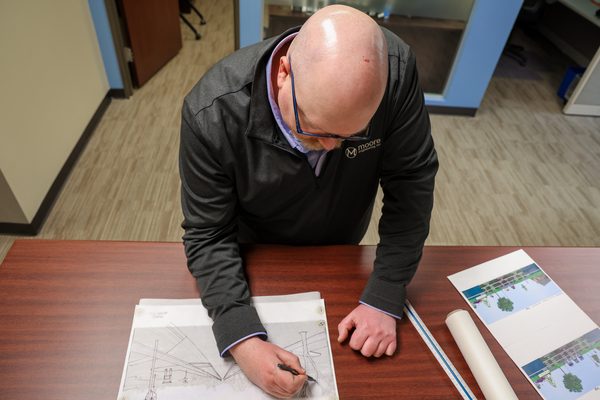
Landscape Architects Key Partners in Engineering Design
When you hear “landscape architecture,” what do you think? Do you remember the unique features of a park you love? Or a commercial parking lot with trees, mulch, and natural grasses in the boulevard? How about an amphitheater that is perfectly sloped into an existing hillside?
These opportunities for beauty and function define the efforts of landscape architects, who use the natural environment and the latest technological tools to create spaces that feel comfortable, harmonious, and uplifting.
April is World Landscape Architecture Month
Every April gives us the opportunity to celebrate the craft that brings the elements of the natural world, technology, and psychology together to create optimal outdoor environments.
Chad Feigum is Moore Engineering’s senior landscape architect. In that role, he works with diverse projects across sectors to enhance the outcome and make it a better experience for the people who experience the finished project space.

Natural Elements Enhance Design, Bolster the Environment
Feigum points out that natural elements are often used to accomplish a project objective, while giving the environment a boost. Concrete, asphalt and building surfaces absorb and radiate heat, often making urban environments less comfortable and attractive.
Integrating a tree canopy into an urban street design, for example, provides shade and reduces the amount of heat that reaches the hard surfaces on the ground. The canopy offers relief from the sun while beautifying the area and making it more attractive for users of that space. It becomes a place people want to spend time, instead of an area they mindlessly pass through as they travel from one place to another.

Green Infrastructure
Harnessing nature and using it as infrastructure is known as “green infrastructure.” We see examples in all sorts of designs, from rooftop gardens and grass to stormwater management. Grass, shrubs, trees, rocks, mulch, sand, and soil provide the raw material to reduce an engineering project’s environmental footprint while accomplishing the desired engineering outcome.
According to the American Society of Landscape Architects (ASLA), the transportation sector produces up to 30% of the world’s greenhouse gases. The industry advocates for reducing the environmental impact of travel by creating more walkable spaces, making roadways multi-modal (e.g. bicycle, scooter, and car lanes), using natural elements to capture harmful runoff from roadways, and encouraging lower emission vehicle use by providing amenities like charging stations and more convenient parking for compact vehicles.
Many other types of engineering projects can also apply the principles of green landscaping. Flood protection and prevention projects use natural design elements as much as possible. Rock formations perform wonderfully to slow down the flow of water. Sand and other soils are nature’s filters to remove sediment, pollutants, and other impurities. And grass roofs and walls provide the insulation and natural cooling effect that reduces the need for air conditioning and heating systems.

Balanced, Sustainable Design
Of course, it’s always a balance to satisfy the many stakeholders in engineering projects. By being aware of opportunities and modeling options, landscape architects help engineers find innovative solutions to make our human spaces more accessible, more comfortable, and more environmentally sound.

Your Trusted Partner
Chad and his team are here to talk about your project and how landscape architecture can contribute to make it more sustainable, more beautiful, and more usable.